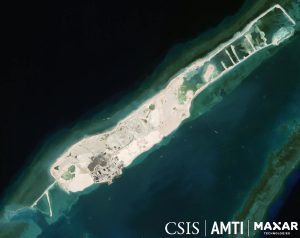Vietnam has “significantly accelerated” the expansion of its outposts in the Spratly Islands over the last six months, a U.S. think tank said last week, putting Hanoi on pace for a “record year of island building” in 2024.
In a briefing published on June 7, the Asia Maritime Transparency Initiative (AMTI) stated that the country had created “almost as much new land as it had in the previous two years combined.”
AMTI, run by the Center for Strategic and International Studies in Washington, D.C., said that since November 2023, Vietnam had created 692 new acres (280 hectares) of land across 10 features in the Spratly Islands. In comparison, it made 404 acres (163.5 hectares) of land in the first 11 months of 2023 and 342 acres (138.4 hectares) in all of 2022.
Barque Canada Reef remains Vietnam’s largest outpost in the Spratlys, the report said, nearly doubling over the last six months from 238 to 412 acres (96 to 167 hectares).
According to AMTI, Vietnam has considerably closed the gap with China in terms of the amount of space that it has created in the Spratly Islands. The country now boasts five of the 10 largest features in the Spratly Islands, which are occupied (and disputed) by China, Vietnam, the Philippines, Taiwan, Malaysia, and Brunei. While the three largest Chinese-occupied features – Mischief Reef, Subi Reef, and Fiery Cross Reef – remain the largest by a considerable way, the next four largest outposts are all newly expanded Vietnamese features: Barque Canada Reef, Namyit Island, Pearson Reef, and Discovery Great Reef. The remaining positions in the top ten are taken up by Itu Aba (occupied by Taiwan), Thitu Island (the Philippines), and Sand Cay (Vietnam).
Vietnam’s total dredging and landfill in disputed areas of the South China Sea amounts to approximately 2,360 acres (955 hectares), around half of China’s 4,650 acres (1,882 hectares), up from just 329 acres (133 hectares) three years ago.
However, while Vietnam’s expanding acreage in the Spratly Islands is now comparable to the real estate that China has reclaimed over the past decade, it still faces a large gap in terms of facilities. Subi, Mischief, and Fiery Cross reefs now each boast multi-story administrative buildings, advanced radar arrays, jet hangars, and 3,000-meter runways capable of handling the largest Chinese bombers. The other four reclaimed Chinese features in the Spratly Archipelago include similarly advanced facilities on a smaller scale.
Vietnam boasts a single 1,300-meter runway on Spratly Island, though AMTI noted that Barque Canada Reef now measures 4,318 meters in length, giving it “the potential to host a 3,000-meter runway like those that China has at Fiery Cross, Mischief, and Subi Reefs.”
AMTI notes that Vietnam has also begun “preliminary construction” of new facilities on its 10 features. “Notable developments include the completion of a boat ramp on Namyit Island and the construction of a new harbor at Central Reef,” the briefing stated. It stated that temporary helipads could be seen at a number of the artificial islands, while “trenches and coastal defense emplacements typical of Vietnam’s Spratly outposts can be seen underway at several features.”
The rash of reclamation and dredging activity indicates Vietnam’s desire to close the gap with China in the disputed waterway and create its own “facts on the ground” at a time of growing tensions in disputed waters, particularly between China and the Philippines.
It is unlikely that Vietnam will ever eclipse China’s “island fortresses,” either in qualitative or quantitative terms, but its efforts indicate a desire to hold the line against Chinese incursions, defend its sovereign claims in the Spratly Islands, and help preserve the tense status quo in contested waters.
































